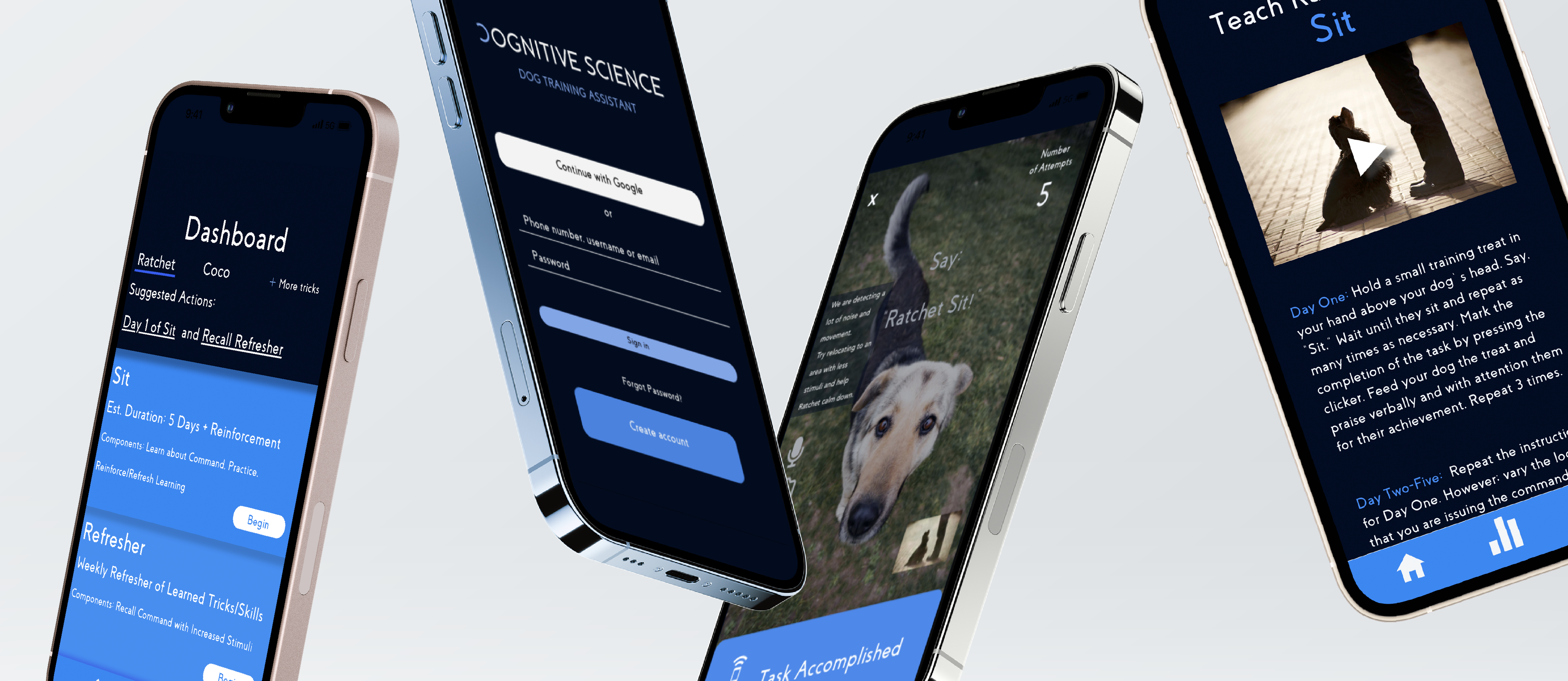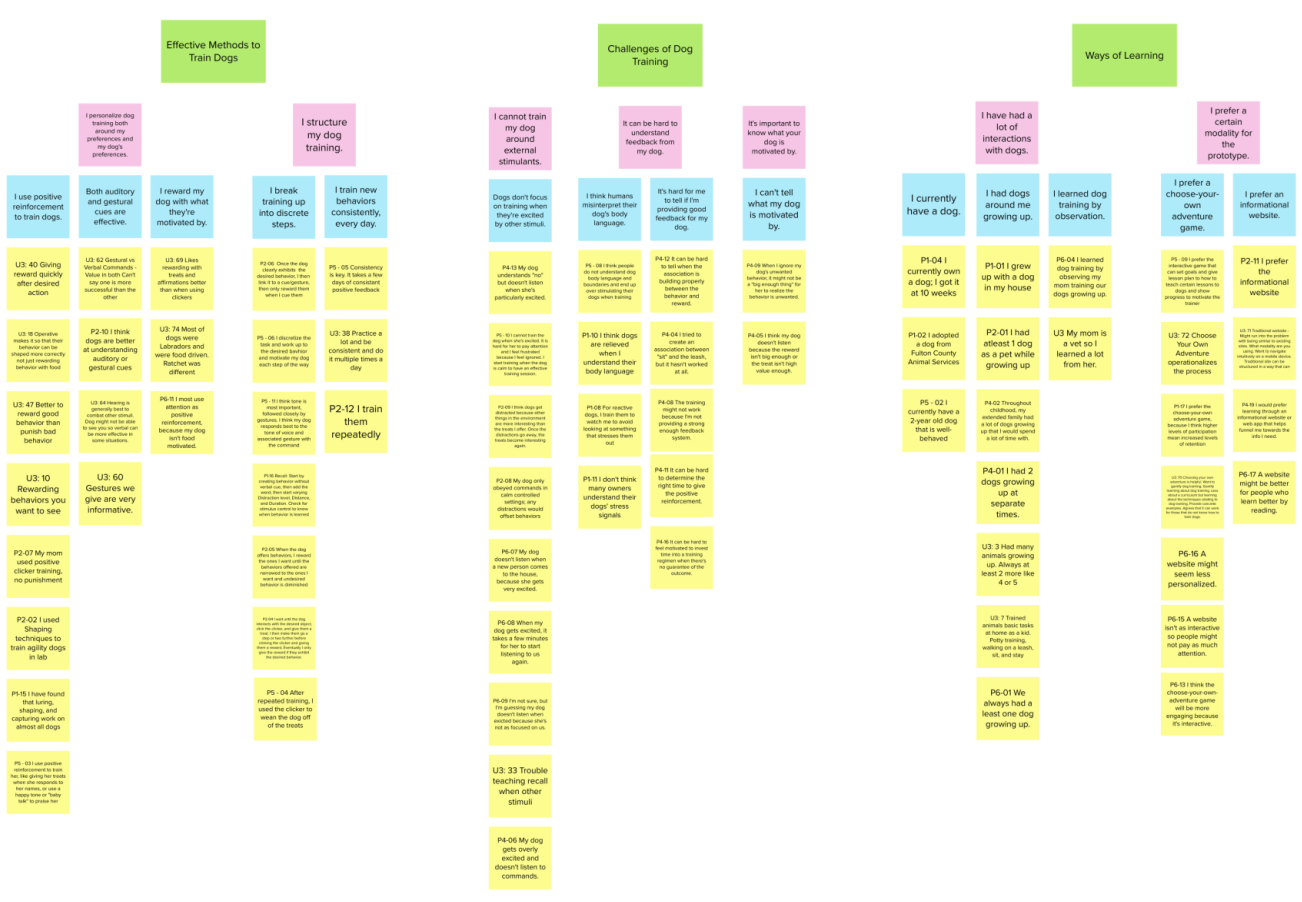

Dognitive Science
| Role | Year | Tech |
| UI/UX Designer & Researcher | 2021 | Illustrator and Adobe XD |
Our goal was to develop a digital tool to help individuals improve their dog training skills by more closely aligning their
understandings of dog cognition with those of professional trainers.
Our design is grounded in qualitative data collected through semi-structured interviews.
How do novice/intermediate trainers approach a training task as opposed to a professional
trainer?
What distinguishes a novice/intermediate trainer from a professional trainer in terms of why
they train dogs the way they do?
In this stage of data collection, we conducted virtual semi-structured interviews (30-60 minutes each) with six participants across a
variety of experience levels of dog training.
• One participant is a Certified Professional Dog Trainer-Knowledge Assessed
(CPDT-KA).
• Two participants are researchers who have worked in dog-related cognitibe research and have experience training dogs for research.
• Final three participants are dog owners who have done some informal training with their dogs at home.

We used the affinity mapping framework to identify overarching themes and patterns in our participants’ interviews. Our team members all reviewed
the data and collaboratively and dynamically
sorted our notes, promoting interrater reliability.
| Green – Primary Themes | Pink – Secondary Themes | Blue – Tertiary Themes |
| Effective Methods to Train dogs | I personalize dog training both around my preferences and my dog's preferences. | I use positive reinforcement to train dogs. |
| Both auditory and gestural cues are effective. | ||
| I reward my dog with what they're motivated by. | ||
| I structure my dog training. | I break training up into discrete steps. | |
| I train new behaviors consistently, every day | ||
| Challenges of Dog Training | I cannot train my dog around external stimulants. | Dogs dont focus on training when they're excited by other stimuli |
| It can be hard to understand feedback from my dog. | I think humans misinterpret their dog's body language. | |
| It's hard for me to tell if I'm providing good feedback for my dog. | ||
| It's important to know what your dog is motivated by | I can't tell what my dog is motivated by | |
| Ways of Learning | I have had a lot of interactions with dogs | I currently have a dog |
| I had dogs aroung me growing up | ||
| I learned dog training by observation | ||
| I prefer a certain modality for the prototype | I prefer to choose-your-own-adventure game | |
| I prefer an informational website |
Our affinity mapping process yields some key insights into aligning dog owners’ cognitive processes with those of professional dog trainers.
Participants with successful prior experience in training dogs discussed how understanding conditioning approaches (such as operant and classical
conditioning) assisted in effective training. In addition, successful trainers emphasized understanding dog body language and structuring
personalized training regimens.
From our interviews with dog owners who were not successful in training their dogs, we gathered that many of them could not tell why their dog
was doing what it was doing.
Or if their actions had any direct impact on the dog.
They also expressed that during training,
they were uncertain as to whether the dog was learning or if their feedback was effective.
The owners did not have an accurate
representation of the dog’s behaviors and could not accurately map those behaviors to emotional states. Because of this, the owners believed that
their work was in vain deterred them from future training efforts.
More experienced dog trainers mentioned that this fundamental misunderstanding of canine body language can lead to high distress for both the dog
and the trainer.
This finding is important to note so that we can include common dog behaviors and stressors for trainers to avoid
implementing.
Dog owners who struggled with training expressed that their dogs would behave well when in low-stimulus environments but would appear
to ignore or forget their training in high-stimulus environments. This finding is important for our deliverable so that we can implement a way to
check environmental controls.
• Effective dog training fundamentally relies on effective communication and consistency.
• Struggling dog trainers should first identify what
motivates their dog (treats, toys, affection, etc.) and understanding a dog’s body language.
• Dog behavior is predictable based on the stimuli offered and the motivating goal or reward.

“Dognitive Science”, is a mobile application prototype that created using Adobe Illustrator and Adobe XD. All design decisions were influenced by key insights obtained from our interviews.
We recruited dog owners that were not professional dog trainers to test our prototype.
We conducted cognitive walkthroughs with each participant to identify design weaknesses and to determine whether or not the app is usable.
The task will require users to teach the dog to learn how to sit. Mainly, we want to see if the user can glean useful information from the training tool.
At the end of the test, we will ask the participant the following questions:
Based on initial test, we were able to:
1) improve upon the usability and design of our app
2) understand if the tool is working as intended.